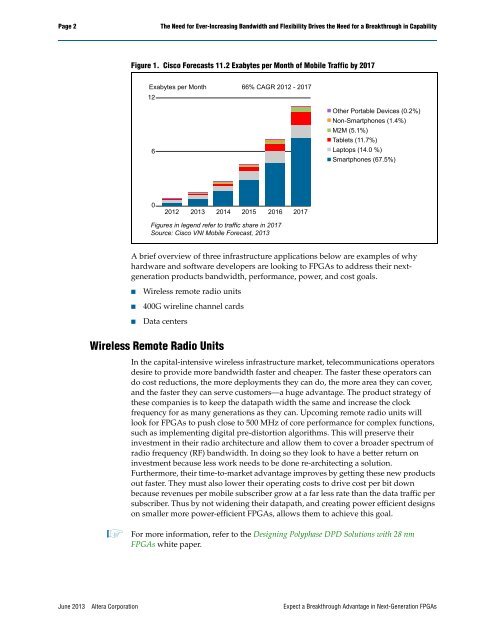Expect a Breakthrough Advantage in Next-Generation FPGAs - Altera
Expect a Breakthrough Advantage in Next-Generation FPGAs - Altera
Expect a Breakthrough Advantage in Next-Generation FPGAs - Altera
Create successful ePaper yourself
Turn your PDF publications into a flip-book with our unique Google optimized e-Paper software.
Page 2<br />
The Need for Ever-Increas<strong>in</strong>g Bandwidth and Flexibility Drives the Need for a <strong>Breakthrough</strong> <strong>in</strong> Capability<br />
Figure 1. Cisco Forecasts 11.2 Exabytes per Month of Mobile Traffic by 2017<br />
Exabytes per Month 66% CAGR 2012 - 2017<br />
12<br />
6<br />
Other Portable Devices (0.2%)<br />
Non-Smartphones (1.4%)<br />
M2M (5.1%)<br />
Tablets (11.7%)<br />
Laptops (14.0 %)<br />
Smartphones (67.5%)<br />
0<br />
2012 2013 2014 2015 2016 2017<br />
Figures <strong>in</strong> legend refer to traffic share <strong>in</strong> 2017<br />
Source: Cisco VNI Mobile Forecast, 2013<br />
A brief overview of three <strong>in</strong>frastructure applications below are examples of why<br />
hardware and software developers are look<strong>in</strong>g to <strong>FPGAs</strong> to address their nextgeneration<br />
products bandwidth, performance, power, and cost goals.<br />
■<br />
■<br />
■<br />
Wireless remote radio units<br />
400G wirel<strong>in</strong>e channel cards<br />
Data centers<br />
Wireless Remote Radio Units<br />
In the capital-<strong>in</strong>tensive wireless <strong>in</strong>frastructure market, telecommunications operators<br />
desire to provide more bandwidth faster and cheaper. The faster these operators can<br />
do cost reductions, the more deployments they can do, the more area they can cover,<br />
and the faster they can serve customers—a huge advantage. The product strategy of<br />
these companies is to keep the datapath width the same and <strong>in</strong>crease the clock<br />
frequency for as many generations as they can. Upcom<strong>in</strong>g remote radio units will<br />
look for <strong>FPGAs</strong> to push close to 500 MHz of core performance for complex functions,<br />
such as implement<strong>in</strong>g digital pre-distortion algorithms. This will preserve their<br />
<strong>in</strong>vestment <strong>in</strong> their radio architecture and allow them to cover a broader spectrum of<br />
radio frequency (RF) bandwidth. In do<strong>in</strong>g so they look to have a better return on<br />
<strong>in</strong>vestment because less work needs to be done re-architect<strong>in</strong>g a solution.<br />
Furthermore, their time-to-market advantage improves by gett<strong>in</strong>g these new products<br />
out faster. They must also lower their operat<strong>in</strong>g costs to drive cost per bit down<br />
because revenues per mobile subscriber grow at a far less rate than the data traffic per<br />
subscriber. Thus by not widen<strong>in</strong>g their datapath, and creat<strong>in</strong>g power efficient designs<br />
on smaller more power-efficient <strong>FPGAs</strong>, allows them to achieve this goal.<br />
1 For more <strong>in</strong>formation, refer to the Design<strong>in</strong>g Polyphase DPD Solutions with 28 nm<br />
<strong>FPGAs</strong> white paper.<br />
June 2013 <strong>Altera</strong> Corporation <strong>Expect</strong> a <strong>Breakthrough</strong> <strong>Advantage</strong> <strong>in</strong> <strong>Next</strong>-<strong>Generation</strong> <strong>FPGAs</strong>
















